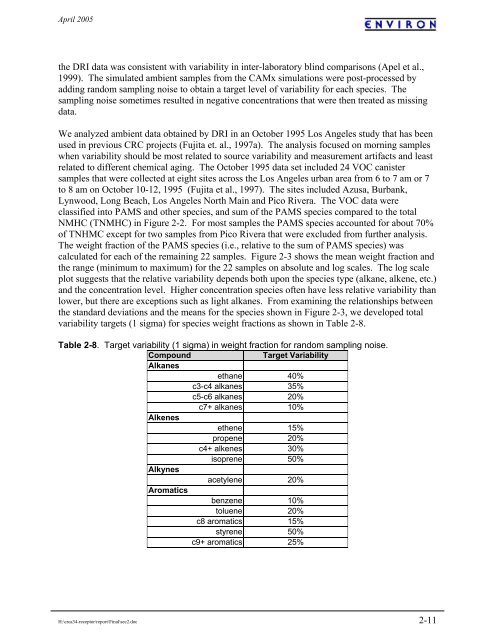CRC Report No. A-34 - Coordinating Research Council
CRC Report No. A-34 - Coordinating Research Council
CRC Report No. A-34 - Coordinating Research Council
You also want an ePaper? Increase the reach of your titles
YUMPU automatically turns print PDFs into web optimized ePapers that Google loves.
April 2005<br />
the DRI data was consistent with variability in inter-laboratory blind comparisons (Apel et al.,<br />
1999). The simulated ambient samples from the CAMx simulations were post-processed by<br />
adding random sampling noise to obtain a target level of variability for each species. The<br />
sampling noise sometimes resulted in negative concentrations that were then treated as missing<br />
data.<br />
We analyzed ambient data obtained by DRI in an October 1995 Los Angeles study that has been<br />
used in previous <strong>CRC</strong> projects (Fujita et. al., 1997a). The analysis focused on morning samples<br />
when variability should be most related to source variability and measurement artifacts and least<br />
related to different chemical aging. The October 1995 data set included 24 VOC canister<br />
samples that were collected at eight sites across the Los Angeles urban area from 6 to 7 am or 7<br />
to 8 am on October 10-12, 1995 (Fujita et al., 1997). The sites included Azusa, Burbank,<br />
Lynwood, Long Beach, Los Angeles <strong>No</strong>rth Main and Pico Rivera. The VOC data were<br />
classified into PAMS and other species, and sum of the PAMS species compared to the total<br />
NMHC (TNMHC) in Figure 2-2. For most samples the PAMS species accounted for about 70%<br />
of TNHMC except for two samples from Pico Rivera that were excluded from further analysis.<br />
The weight fraction of the PAMS species (i.e., relative to the sum of PAMS species) was<br />
calculated for each of the remaining 22 samples. Figure 2-3 shows the mean weight fraction and<br />
the range (minimum to maximum) for the 22 samples on absolute and log scales. The log scale<br />
plot suggests that the relative variability depends both upon the species type (alkane, alkene, etc.)<br />
and the concentration level. Higher concentration species often have less relative variability than<br />
lower, but there are exceptions such as light alkanes. From examining the relationships between<br />
the standard deviations and the means for the species shown in Figure 2-3, we developed total<br />
variability targets (1 sigma) for species weight fractions as shown in Table 2-8.<br />
Table 2-8. Target variability (1 sigma) in weight fraction for random sampling noise.<br />
Compound<br />
Target Variability<br />
Alkanes<br />
ethane 40%<br />
c3-c4 alkanes 35%<br />
c5-c6 alkanes 20%<br />
c7+ alkanes 10%<br />
Alkenes<br />
ethene 15%<br />
propene 20%<br />
c4+ alkenes 30%<br />
isoprene 50%<br />
Alkynes<br />
acetylene 20%<br />
Aromatics<br />
benzene 10%<br />
toluene 20%<br />
c8 aromatics 15%<br />
styrene 50%<br />
c9+ aromatics 25%<br />
H:\crca<strong>34</strong>-receptor\report\Final\sec2.doc 2-11
















